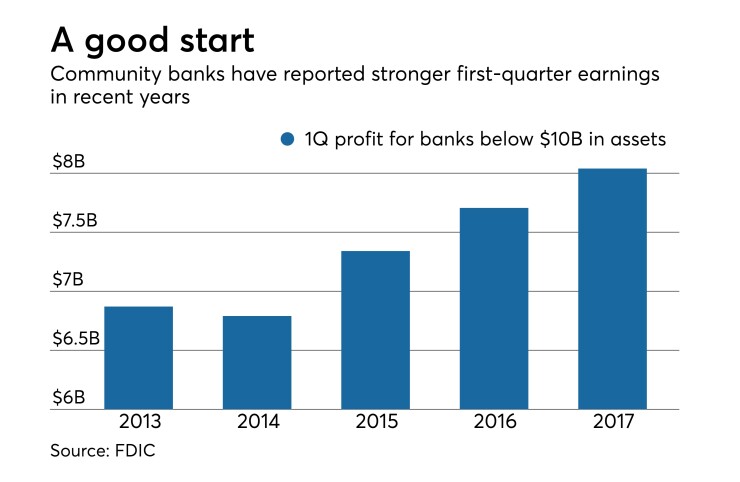So much for high hopes for accelerated loan growth at community banks.
Just a few months ago, many industry observers predicted blowout first-quarter results from smaller institutions, largely based on optimism after the passage of sweeping tax reform. The mood now, given bankers' commentary and fears of a trade war, is more subdued.
So expect analysts to ask more questions about pent-up demand during upcoming quarterly conference calls.

“It appears that the tax cut has not spurred on loan growth, so I think people will be looking forward to see how pipelines are building ... and if we’re starting to see signs of that potential benefit,” said Brian Zabora, an analyst at Hovde Group.
"We were expecting the tax cuts to free some pent-up demand and get some businesses investing," said Joseph Gladue, an analyst at Merion Capital Group. "Increased uncertainty may have muted some of the benefit" of lower taxes.
Recent data from the Federal Reserve and guidance from bankers also indicate tempered growth.
"We had hoped to see ... more demand from existing clients or capital expenditures, more financing," Keith Cargill, president and CEO of Texas Capital Bancshares in Dallas, said in early March during a conference hosted by Raymond James. "That has just not showed up yet."
Texas Capital is hopeful that more clients will make capital expenditures once they realize that favorable writeoff provisions exist in the tax law, though it is unclear if that will happen in the second quarter, Cargill added.
Cargill isn't the only banker prepping investors for a delayed benefit from tax reform.
“We talk to various management teams and the commentary and the body language around loan pricing was a little bit more negative," said William Wallace, a Raymond James analyst.
A number of specific narratives will also gain added attention when calls begin in earnest.
Banks around New York, notably those that focus on multifamily and commercial real estate, could struggle to book loans at attractive yields, said Collyn Gilbert at Keefe, Bruyette & Woods.
“We’ve heard some discouraging anecdotal comments throughout the quarter that loan pricing … has come under significant pressure,” Gilbert said, attributing the trend to smaller banks that are reducing rates to accelerate loan growth.
"The thought was it would take some time — maybe later this calendar year — before we started to see pricing pressure," Gilbert said. "It seems ... that it is happening more quickly.”
Mortgage lending is another likely soft spot. The Mortgage Bankers Association has forecast a double-digit decline in originations from the fourth quarter. Industry observers believe most of the decline will be tied to refinancing activity.
"Some of the banks we follow have been encouraged by the purchase market, which is more contingent on the strength of the economy and jobs," Gilbert said. "They have in the last couple years really been shifting their business models away from refinance."
Reduced mortgage production could cut into fee income for community banks, most of which tend to sell their loan production. However, mortgage servicing rights typically benefit from a rising rate environment.
A slowdown in mortgage originations has led a number of banks to move into Small Business Administration lending, Wallace said. "The volume in the SBA program has been strong in last five years,” he said.
Another area to watch is credit quality, which has surpassed expectations lately. Other than a few specific segments, portfolios have held up well in recent quarters.
Analysts began 2018 predicting higher reserves, only to hear bankers discuss lower chargeoffs and stellar loan performance, Gilbert said.
"So we are sort of waiting for that inflection point,” she said.
Hilary Burns and Jackie Stewart contributed to this article.





